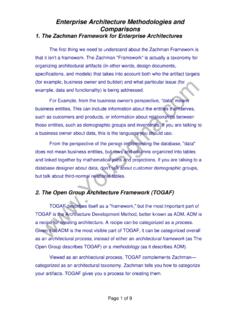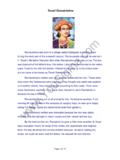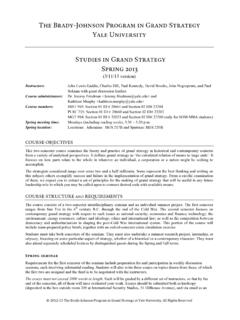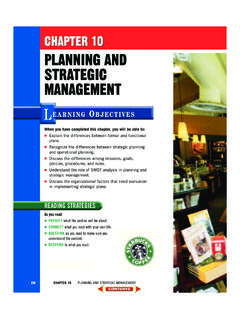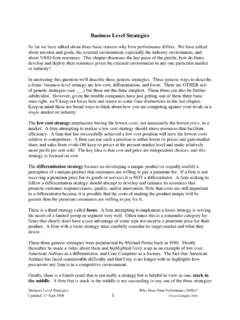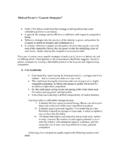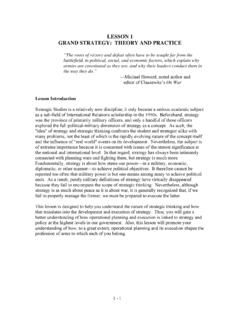Transcription of Grand or Business Strategies - Great Informational Website ...
1 Grand or Business Strategies Strategy Analysis and Choice is a process that reconciles strategic actions, market opportunities, corporate strengths and resources, values of managers, and legal requirements and social responsibilities to select a "best" mission, strategic thrust, and set of strategic actions. Grand Strategies , often called master or Business Strategies provide basic direction for strategic actions. They are the basis of coordinated and sustained efforts directed toward achieving long-term Business objectives. Grand Strategies indicate the time period over which long-range objectives are to be achieved. Thus, a Grand strategy can be defined as a comprehensive general approach that guides a firm s major actions.
2 Business managers can use tools and techniques such as Grand Strategy Selection Matrix or Grand Strategy Cluster or Matched-pair Analysis to design means that will be used to achieve long-term objectives. The Model for Grand Strategy Cluster is shown in Figure 1. The technique is based on the idea that the situation of a Business is defined in terms of the growth rate of the general market and the firm s competitive position in that market. When these factors are considered simultaneously, a Business can be broadly categorized in one of four quadrants: (I) strong competitive position in a rapidly growing market, (II) weak position in a rapidly growing market, (III) weak position in a slow-growth market, or (IV) strong position in a slow-growth market.
3 Each of these quadrants suggests a set of promising possibilities for the selection of a Grand strategy. Figure 1 Grand or Business Strategies The Model for Grand Strategy Selection Matrix is shown in Figure 2. The basic idea underlying the matrix is that two variables are of central concern in the selection process: (1) the principal purpose of the Grand strategy and (2) the choice of an internal or external emphasis for growth or profitability. Figure 2 Grand or Business Strategies The principal Grand Strategies are: 1. A concentrated growth strategy involves focusing on increasing market share in existing markets. This strategy is also sometimes called a concentration or market dominance strategy.
4 In a stable environment where demand is growing, concentrated growth is a low risk strategy. Concentration may involve increasing the rate of use of a product by current customers; attracting competitor's customers; and/or attracting nonusers/ new customers. Example: A. With headquarters in Columbus, Ohio, Chemlawn is the North American leader in professional lawn care. Like others in the lawn-care industry, Chemlawn is experiencing a steadily declining customer base. Market analysis shows that the decline is fueled by negative environmental publicity, perceptions of poor customer service, and concern about the price versus the value of the company s services, given the wide array of do-it-yourself alternatives.
5 Chemlawn s approach to increasing market share hinges on addressing quality, price, and value issues; Grand or Business Strategies discontinuing products that the public or environmental authorities perceive as unsafe; and improving the quality of its workforce. 2. A market development strategy involves selling present products or services in new markets. Managers take actions like targeting promotions, opening sales offices and creating alliances to operationalize a market development strategy. Example: A. Kmart pursued market development with its recent emphasis on increasing market share among Hispanics B. Du Pont used market development when it found a new application for Kevlar, an organic material that police, security, and military personnel had used primarily for bulletproofing.
6 Kevlar now is being used to refit and maintain wooden-hulled boats, since it is lighter and stronger than glass fibers and has 11 times the strength of steel. 3. A product development strategy focuses on substantial modification of existing products developing new products for currently served markets and customers. The focus is often on products/services related to current offering. Sometimes quality variations or new models or sizes of products are developed. As part of a product development strategy, a company may emphasize getting a product to market quickly, developing a product that can be sold at the lowest cost, or developing a product that has the highest level of product performance, or developing a product with high levels of product quality and reliability.
7 In some situations, product development is constrained by a development budget. Example: A. Pepsi changed its strategy on beverage products by creating new products to follow the industry movement away from mass branding. This new movement was designed to attract a younger, hipper customer segment. Pepsi s new products include a version of Mountain Dew, called Code Red, and new Pepsi brands, called Pepsi Twist and Pepsi Blue B. Gerber s recent introduction included 52 items that ranged from feeding accessories to toys and children s wear. Grand or Business Strategies 4. A vertical integration is a Grand strategy that involves acquiring firms that supply it with inputs (such as raw materials) or are customers for its outputs (such as warehousers for finished products).
8 The transaction may involve stock purchase, buying assets, or stock swap. Backward vertical integration involves acquiring a firm at an earlier stage of the value chain. Forward integration involves acquiring a firm at a later stage in the value chain. Example: A. Amoco emerged as North America s leader in natural gas reserves and products as a result of its acquisition of Dome Petroleum. This backward integration by Amoco was made in support of its downstream businesses in refining and in gas stations, whose profits made the acquisition possible. 5. A Concentric diversification is one type of strategic thrust. Concentric diversification focuses on creating a portfolio of related businesses.
9 The portfolio is usually developed by acquisition rather than by internal new Business creation. Product-market synergies are a major issue in creating the portfolio of related strategic Business units (SBUs). Example: A. Head Ski initially sought to diversify into summer sporting goods and clothing to offset the seasonality of its snow Business . 6. A conglomerate diversification involves acquiring a portfolio of businesses based on financial performance criteria. Product-market synergies are not an issue. Example: A. ITT, Textron, American Brands, Litton, Industries, Fuqua, and I. C. Industries seek is financial synergy. For example, they may seek a balance in their portfolios between current businesses with cyclical sales and acquired businesses with countercyclical sales, between highcash/ low-opportunity and low-cash/high-opportunity businesses, or between debt-free and highly leveraged businesses.
10 7. A horizontal integration Strategies focus on acquiring firms in current markets or in new markets. Such acquisitions eliminate competitors and provide the acquiring firm with access to new markets. A horizontal integration strategy can support a concentrated growth or a market development strategy. Page 5 of 8 Grand or Business Strategies Example: A. Warner-Lambert s acquisition of Parke Davis, which reduced competition in the ethical drugs field for Chilcott Laboratories, a firm that Warner-Lambert previously had acquired. B. long-range acquisition pattern of White Consolidated Industries, which expanded in the refrigerator and freezer market through a Grand strategy of horizontal integration, by acquiring Kelvinator Appliance, the Refrigerator Products Division of Bendix Westinghouse Automotive Air Brake, and Frigidaire Appliance from General Motors.
